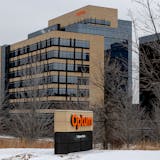The higher I climbed, the more I felt the tower tremble. And my legs, too.
Below me, Spanish moss hung limp on leafless trees. The swamp in winter looked ghostly. Then a nervous moan cut through the birdsong.
Not an apparition, it was my own voice.
"It's great up here," a friend called encouragingly. I willed myself to the top platform of the Perry Lakes Park Birding Tower, a 100-foot-tall, open-air stairway that grows narrower and steeper with each successive landing. It seemed almost like a funhouse distortion, except the arrangement actually helps keep the tower upright.
I peered over the railing to look down on cypresses and tupelos below my feet. Warblers flitted among branches. I could see far across western Alabama's rolling farmland to distant hills. The view was sweet, but I was on a special architecture tour and had come to see the tower itself. The relative skyscraper, made of parts from a defunct fire tower purchased for $10, draws birders and day-trippers to the once-abandoned nature park.
Who would have thought that four architecture students could design and build — by themselves — the literal and figurative high point of this reborn park in Perry County, one of Alabama's poorest?
Just such transformative feats have been occurring regularly in Alabama's agricultural Black Belt since 1993, when the Rural Studio, part of Auburn University's School of Architecture, launched in Hale County.
Since then, the Rural Studio has gained international renown for making stunning, inventive buildings for residents and communities in one of the most impoverished pockets of America. Hale County was the focus of James Agee and Walker Evans' 1939 book, "Let Us Now Praise Famous Men." My drive through the region suggests that the paucity they documented hasn't lifted, even now.


